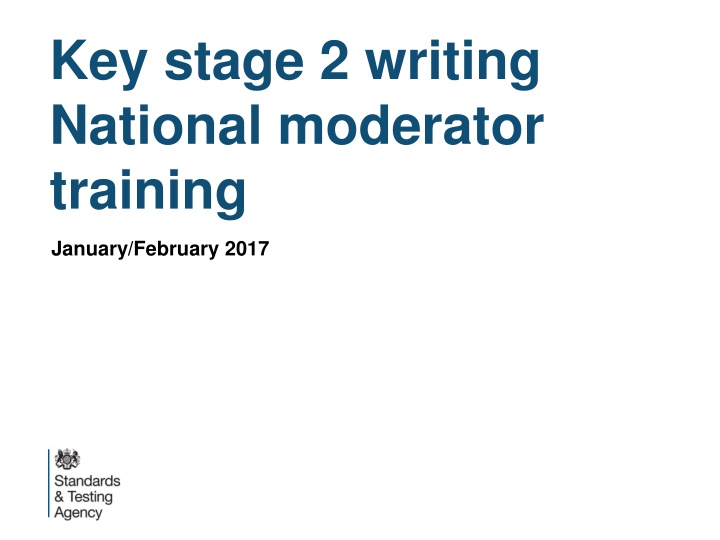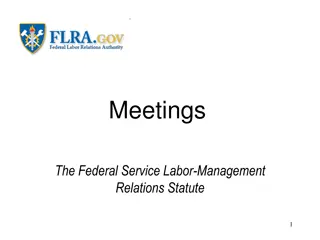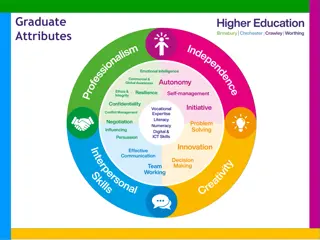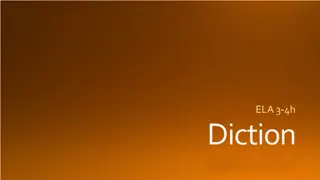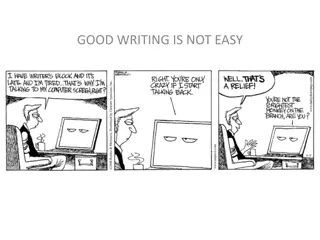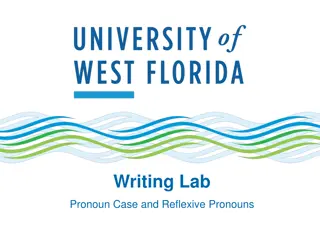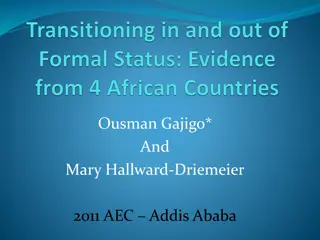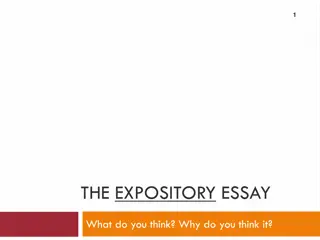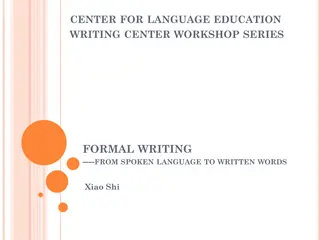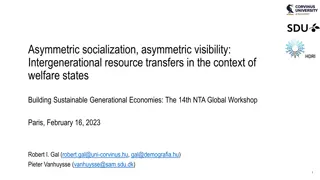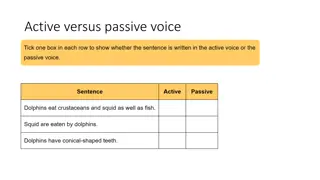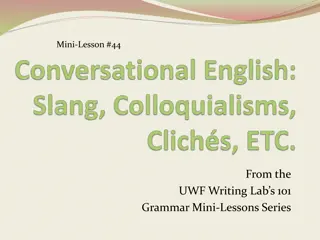Mastering Levels of Formality in Writing: Key Stage 2 Training Insights
Explore the nuances of formality in language use across different contexts, as detailed in the Key Stage 2 Writing National Moderator Training in January/February 2017. Learn how to manage shifts between formal and informal language through precise vocabulary selection and grammatical manipulation. Delve into the art of working at greater depth within the expected standard, where writing for various purposes and audiences demands a keen understanding of formality markers. Discover the importance of maintaining consistency in formal shifts within single and multiple pieces of writing to achieve academic excellence.
Download Presentation

Please find below an Image/Link to download the presentation.
The content on the website is provided AS IS for your information and personal use only. It may not be sold, licensed, or shared on other websites without obtaining consent from the author.If you encounter any issues during the download, it is possible that the publisher has removed the file from their server.
You are allowed to download the files provided on this website for personal or commercial use, subject to the condition that they are used lawfully. All files are the property of their respective owners.
The content on the website is provided AS IS for your information and personal use only. It may not be sold, licensed, or shared on other websites without obtaining consent from the author.
E N D
Presentation Transcript
Key stage 2 writing National moderator training January/February 2017
Managing shifts between levels of formality through selecting vocabulary precisely and by manipulating grammatical structures Working at greater depth within the expected standard
"It fascinates me how differently we all speak in different circumstances. We have levels of formality, as in our clothing. There are very formal occasions, often requiring written English: the job application or the letter to the editor - the dark-suit, serious-tie language, with everything pressed and the lint brushed off. There is our less formal out-in-the-world language - a more comfortable suit, but still respectable.
There is language for close friends in the evenings, on weekends - blue-jeans-and-sweat-shirt language, when it s good to get the tie off. There is family language, even more relaxed, full of grammatical short cuts, family slang, echoes of old jokes that have become intimate shorthand - the language of pyjamas and uncombed hair. Finally, there is the language with no clothes on; the talk of couples - murmurs, sighs, grunts - language at its least self-conscious, open, vulnerable, and primitive. Robert MacNeil, Wordstruck: A Memoir (Viking, 1989)
Expected standard Greater depth The pupil can write for a range of purposes and audiences (including writing a short story): The pupil can write for a range of purposes and audiences: managing shifts between levels of formality through selecting vocabulary precisely and by managing grammatical structures selecting vocabulary and grammatical structures that reflect the level of formality required mostly correctly
To meet the requirements for greater depth, the shifts need to be within single pieces of writing, in more than one piece of writing, and on more than one occasion within those pieces of writing.
Table discussion What type of vocabulary and grammatical structures are indicators of formality? What type of vocabulary and grammatical structures are indicators of informality?
What Frankie did Several pieces demonstrate the ability to manage shifts in levels of formality by manipulating grammatical structures and by selecting vocabulary precisely. For example, in Pointe Shoes, the shifting levels of formality convey the writer s thoughts and feelings about the subject matter (dance), whereas in The Cornwall News, the shifts in formality are used to convey the interweaving of fact and opinion.
Explanatory writing on Pointe Shoes (Informal) (More formal) Have you ever wondered Keep on reading to find out the Nutcracker you saw They were invented to They are traditionally worn by There is an all male ballet company But as soon as you get into the ballet world This exact thing happened Every dancer has unique feet with varying length, shape, arch, flexibility consequently, most pointe shoe companies make Sometimes they are custom tailored Pointe work is awesome you are now a pointe shoe fan!
Newspaper report We were joking around with her just hours earlier and now she s dead! said one of her brothers, Felix. Another one of her brothers recalled that she had been making a cowrie shell necklace since the start of their holiday two weeks before. They explained that she needed only a few more inches to reach the toaster but tragically those inches cost her her life!
Diary Hello! I called, It s me Cherry! I m home. I ve survived. Why was everyone ignoring me? And then it dawned on me. The miners, the water, the no answering. I leant against the wall and slowly slid down in a crumpled, sobbing heap. I was dead. Nobody survives a drowning in an Atlantic storm. I am very stupid and very, very dead. Then I cried. I cried until there were no more tears. I bit down on my lip until I tasted blood. Blood? The reality of it all came flooding into my mind.
Table activity Your pack contains 7 pieces of writing taken from different collections that were moderated as working at greater depth within the expected standard . 1. A formal letter (Palm Oil) 2. A newspaper report (Pig Palaver) 3. An extended narrative with inserts (Billy s Story) 4. A short first person narrative (The Pie) 5. An information leaflet (London Trip) 6. A narrative (The Creation of the Chelegonaffe) 7. A promotional leaflet (Beecher Woods) You also have some brief contextual information for each piece.
Your task is to decide which of the 7 pieces provide evidence for the statement managing shifts between levels of formality through selecting vocabulary precisely and by managing grammatical structures and which pieces do not. Your table leader will facilitate this activity.
It will not always be appropriate for a writer to shift the level of formality within a piece of writing. Writing can be equally effective when vocabulary and grammatical structures are sustained and adapted to reflect the level of formality appropriate to purpose and audience. However, to be awarded greater depth , there must be evidence that pupils can manage such shifts. Moderators need to recognise tasks that are likely to elicit evidence for this statement.
Dispelling the myths Some common misconceptions
Use of semi-colons and colons At the expected standard, pupils do not need to evidence the use of semi-colons and colons to mark the boundary between independent clauses (although they may do so). It is acceptable for pupils to use a colon to introduce a list and to use semi-colons within lists.
Use of dashes Dashes can be used to mark the boundary between independent clauses or to mark parenthesis. A pair of dashes or a single dash can be used to mark a parenthetical afterthought. Any of these uses can provide evidence for dashes at the expected standard.
Punctuation for parenthesis Commas, dashes and brackets can all indicate parenthesis. However, it is not necessary for pupils to demonstrate all 3 forms of punctuation to indicate parenthesis across a collection of writing.
Bullet points Bullet points may be referred to as punctuation marks or typographical symbols: they are typically used to introduce items in a vertical list. The NC refers to the consistent punctuation of bullet points; therefore, if they are used, the way they are punctuated must be consistent. For example, each item starting with a lower case or upper case letter, but not mixed; each item ending with a full stop or no punctuation, but not mixed etc. However, bullet points do not need to be evidenced for a pupil to be judged as working at any of the 3 standards.
Ellipsis Pupils do not need to demonstrate the use of ellipsis dots as part of the full range of punctuation taught at key stage 2 (although they may choose to do so). In the NC, ellipsis is referenced as a cohesive device, even though it is grouped under terminology alongside other punctuation marks.
Success criteria (1) Success criteria provide pupils with a means of successfully demonstrating their learning. They can also support teachers judgements as to whether a pupil has achieved specific learning intentions in a piece of writing. Pupils can use success criteria to assess their own work, address their own concerns, and identify areas for improvement.
Success criteria (2) If success criteria are over-detailed, they can impact on the independent nature of the writing, for example: I have started a sentence with If, When or Because. I have inserted a comma after a fronted adverbial. I have written a sentence in the passive voice to create suspense, eg They were trapped! Success criteria should encourage pupils to focus on the criteria against which the work will be assessed, without modelling or over-scaffolding the expected outcome.
Identifying the evidence Working at the expected standard
Table activity Your pack contains 5 pieces of writing from one pupil s collection, which was moderated as working at the expected standard . These pieces are representative of a broader range of writing seen during the moderation visit. A) an information leaflet B) a letter C) a short story D) a recount E) a newspaper report. You also have some brief contextual information for each piece.
Your task is to expand the partially populated supporting commentary, using evidence from the pupil s writing to show how it meets each of the interim TA framework statements for the expected standard. You should aim to provide further bullet points for each statement comment on all five pieces of writing across the commentary as a whole highlight or note examples as appropriate No further commentary is required for spelling and handwriting.
Identifying the evidence Read the exemplified commentary. Consider how your comments and examples correspond to those within the exemplified commentary. Are there any aspects of the commentary that require further clarification?
